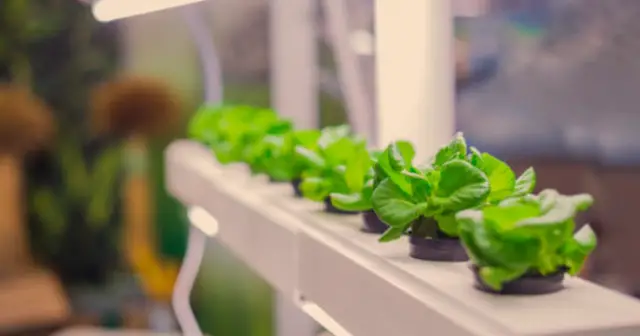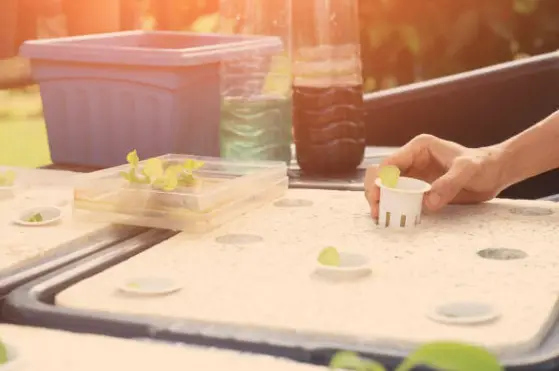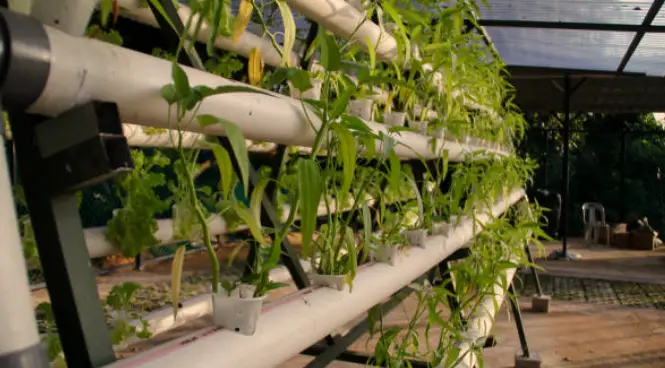Hydroponics is a soilless method of growing plants by supplying a nutrient-rich solution directly to the plant roots. This technique has become increasingly popular in recent years, as it offers several advantages over traditional soil-based gardening.
Hydroponic systems allow gardeners to grow plants more efficiently, using less water and space while providing better control over the growing environment.
Whether you’re a seasoned green thumb or a beginner looking to explore the world of indoor gardening, hydroponic plant cultivation can be an exciting and rewarding endeavor.
Choosing the Right Hydroponic System
There are several different types of hydroponic systems available, each with its own set of pros and cons. Here are some of the most popular options:

1. Deep Water Culture (DWC) System: In a DWC system, plant roots are submerged in a nutrient-rich solution, which is continuously aerated to provide oxygen to the roots. This system is relatively simple and inexpensive to set up, making it an excellent choice for beginners.
2. Nutrient Film Technique (NFT) System: An NFT system involves a shallow stream of nutrient solution that continuously flows over the plant roots. This system is efficient and space-saving, but it requires a more complex setup and may be better suited for advanced growers.
3. Ebb and Flow (Flood and Drain) System: As the name suggests, an ebb and flow system periodically floods the grow tray with nutrient solution and then drains it back into the reservoir. This system is versatile and can accommodate a wide range of plant sizes and types.
4. Drip System: In a drip system, nutrient solution is slowly dripped onto the plant roots through a network of tubing and emitters. This system is highly efficient in terms of water and nutrient usage but requires precise monitoring and maintenance.
5. Aeroponics System: In an aeroponics system, plant roots are suspended in the air and periodically misted with a nutrient solution. This system is highly efficient but requires a more complex setup and may be better suited for experienced growers.
Once you’ve chosen the hydroponic system that best fits your needs, it’s time to gather the necessary components and set it up.
Setting Up Your Hydroponic System
You will need to assemble and configure your hydroponic system. Here’s a step-by-step guide to help you get started:

How to Plant a Hydroponic Plant`
1. Gather the necessary components: Depending on the system you’ve chosen, you’ll need items like a grow tray or container, an air pump (for systems that require aeration), a water pump (for systems with recirculating nutrient solution), grow medium (such as clay pellets, rockwool, or coco coir), and a nutrient solution.
2. Set up the grow tray or container: If you’re using a DWC or ebb and flow system, you’ll need to set up the grow tray or container according to the manufacturer’s instructions. Make sure it’s level and positioned in a suitable location with access to water and electricity.
3. Install the air and water pumps. If your system requires aeration or recirculation of the nutrient solution, install the air and water pumps according to the manufacturer’s guidelines. Ensure that the pumps are functioning correctly and that the tubing is properly connected.
4. Add the grow medium: Depending on the system you’re using, you may need to add a grow medium to support the plant roots. Common options include clay pellets, rockwool cubes, or coco coir. Follow the specific instructions for your chosen medium and system.
5. Mix the nutrient solution: Hydroponic plants require a carefully balanced nutrient solution to thrive. Follow the recommended ratios and mixing instructions provided by the nutrient manufacturer. It’s essential to get the nutrient concentrations right to avoid deficiencies or toxicities.
6. Fill the reservoir: Once the nutrient solution is mixed, carefully pour it into the reservoir or grow tray, ensuring that the roots (or grow medium) will have adequate access to the solution.
7. Test and adjust: Before planting, it’s a good idea to test the pH and nutrient levels of the solution to ensure they’re within the ideal range for your chosen plants. Adjust as needed using pH buffers or additional nutrients.
Now that your hydroponic system is set up and ready to go, it’s time to start planting!
Planting Your Hydroponic Plants
With your hydroponic system prepared, you can now introduce your plants. Here’s how to proceed:

1. Choose your plants: When selecting plants for your hydroponic garden, consider factors like growth rates, nutrient requirements, and compatibility with the system you’ve chosen. Some popular hydroponic plants include leafy greens, herbs, tomatoes, peppers, and strawberries.
2. Start with seedlings or clones: While it’s possible to germinate seeds directly in a hydroponic system, it’s generally easier and more reliable to start with seedlings or clones. This ensures that the plants have a strong root system from the beginning.
3. Prepare the seedlings: If you’ve purchased seedlings or clones, carefully remove them from their containers and gently untangle and spread out the roots. This will help them establish more quickly in the hydroponic system.
4. Plant in the grow medium: If your system uses a grow medium, create a small hole or opening in the medium and gently place the plant’s root ball into it. Lightly pack the medium around the base of the plant to secure it in place.
5. Secure the plants: For systems without a grow medium, you’ll need to secure the plants in place using plant baskets, net pots, or other support structures. Ensure that the roots have adequate access to the nutrient solution.
6. Provide support: As your plants grow, they may require additional support to prevent them from toppling over. Consider using plant stakes, trellises, or other support structures to keep your hydroponic garden tidy and organized.
7. Monitor and adjust: After planting, closely monitor your hydroponic system to ensure that the plants are receiving the right amount of nutrients, water, and oxygen. Adjust the nutrient solution and other parameters as needed to maintain optimal growing conditions.
Maintaining Your Hydroponic Garden
Once your hydroponic plants are established, it’s essential to maintain the system properly to ensure their continued growth and health. Here are some key considerations:
1. Monitor nutrient levels: Regularly test the nutrient solution to ensure that it maintains the correct pH and nutrient concentrations. As plants grow and consume nutrients, you’ll need to replenish the solution accordingly.
2. Change the nutrient solution: Depending on the size of your system and the rate of plant growth, you may need to change the nutrient solution every few weeks or months. This helps to prevent the buildup of waste products and maintain a clean, balanced environment for your plants.
3. Prune and train: As your plants grow, you may need to prune them to encourage bushier growth and better air circulation. Additionally, some plants may require training or support to guide their growth in the desired direction.
4. Manage pests and diseases: Even in a hydroponic system, plants can still be susceptible to pests and diseases. Monitor your plants closely and take prompt action if you notice any signs of infestation or disease. Consider using organic or biological control methods to maintain a healthy growing environment.
5. Provide supplemental lighting: If you’re growing your hydroponic plants indoors or in areas with limited natural light, you’ll need to provide supplemental lighting. Choose grow lights that are appropriate for the specific plants you’re cultivating, and ensure that they receive the correct amount of light for optimal growth.
6. Maintain airflow: Proper airflow is essential for hydroponic plants, as it helps to prevent stagnant conditions and promotes healthy root development. Ensure that your system has adequate ventilation, and consider using fans or air stones to improve air circulation.
7. Monitor water levels and quality: Regularly check the water levels in your hydroponic system and top up as needed. Additionally, keep an eye on water quality by testing for factors like pH, dissolved oxygen, and potential contaminants.
Troubleshooting Common Issues
Even with proper setup and maintenance, you may encounter some challenges along the way. Here are some common issues and tips for troubleshooting:
1. Nutrient deficiencies: If you notice yellowing or discolored leaves, stunted growth, or other signs of nutrient deficiency, it may be time to adjust your nutrient solution.
2. pH imbalances: Maintaining the correct pH level is crucial for hydroponic plants, as it affects nutrient uptake and overall plant health. If you notice signs of pH imbalance, such as stunted growth or leaf discoloration, test the nutrient solution and adjust the pH accordingly.
3. Algae growth: Algae can be a common issue in hydroponic systems, especially those with excessive light exposure or nutrient imbalances. To combat algae growth, consider using opaque reservoirs, reducing light exposure, and maintaining proper nutrient levels.
4. Root rot: Root rot can be caused by a variety of factors, including overwatering, poor aeration, or pathogenic infections. If you notice mushy or discolored roots, address the underlying issue promptly and consider using a root treatment solution or beneficial bacteria to promote healthy root growth.
5. Pests and diseases: As mentioned earlier, hydroponic plants can still be susceptible to pests and diseases. If you notice signs of infestation or disease, take prompt action using appropriate organic or biological control methods.
6. Electrical or mechanical issues: In hydroponic systems with pumps, aerators, or other mechanical components, it’s important to regularly check for any electrical or mechanical issues that could disrupt the system’s functioning.
Advanced Hydroponic Techniques
As you gain experience with hydroponic gardening, you may want to explore more advanced techniques to optimize plant growth and productivity. Here are some options to consider:
1. Nutrient film technique (NFT): NFT systems are highly efficient and can produce high yields in a relatively small space. In an NFT system, a shallow stream of nutrient solution continuously flows over the plant roots, providing a constant supply of water and nutrients.
2. Aeroponics: Aeroponics systems are even more efficient than NFT, as they eliminate the need for a growing medium entirely. In an aeroponics system, plant roots are suspended in the air and periodically misted with a nutrient solution, allowing for optimal oxygen exposure and nutrient uptake.
3. Aquaponics: Aquaponics is a sustainable and closed-loop system that combines hydroponics with aquaculture (fish farming). The waste produced by the fish provides nutrients for the plants, while the plants help to filter and clean the water for the fish, creating a symbiotic ecosystem.
4. Automated systems: As hydroponic technology continues to evolve, there are now automated systems available that can monitor and adjust various parameters, such as nutrient levels, pH, and temperature, to create the ideal growing environment for your plants.
5. Vertical gardening: To maximize space utilization, consider implementing vertical gardening techniques in your hydroponic system. This can involve using specialized grow towers, wall-mounted systems, or other vertical configurations to grow plants in multiple layers.
6. Controlled environment agriculture (CEA): CEA involves creating a fully controlled and optimized growing environment, often in a greenhouse or indoor facility. By precisely controlling factors like lighting, temperature, humidity, and CO2 levels, you can maximize plant growth and productivity while minimizing external environmental factors.




